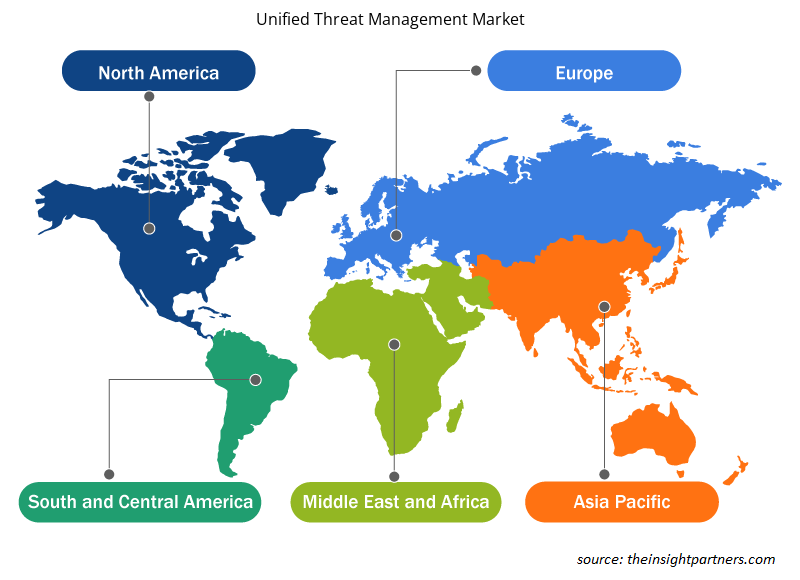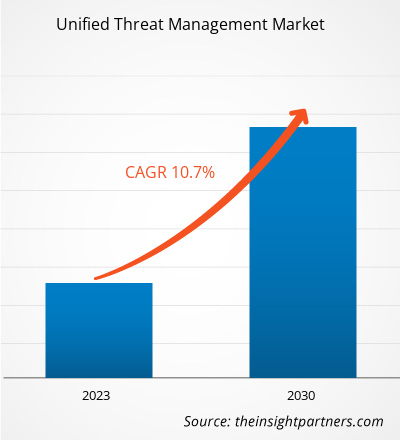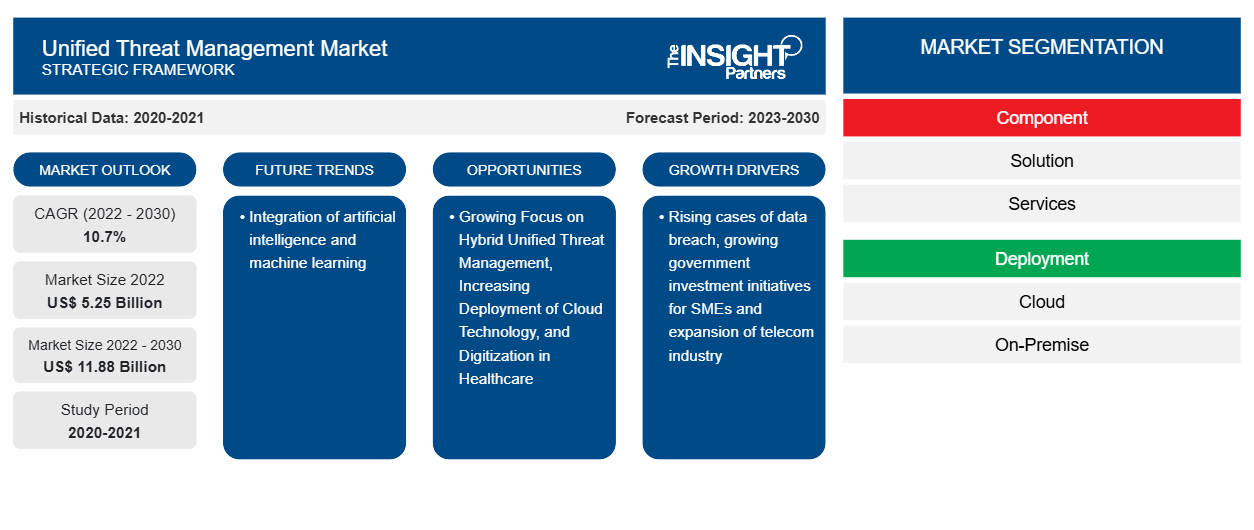统一威胁管理市场规模预计将从 2022 年的 52.5 亿美元增至 2030 年的 118.8 亿美元。预计 2022-2030 年期间该市场的复合年增长率将达到 10.7%。人工智能和机器学习的融合可能仍是市场的主要趋势。
统一威胁管理市场分析
统一威胁管理解决方案的防病毒功能可帮助企业监控网络并检测和阻止病毒破坏其系统或其连接的设备。统一威胁管理的防病毒解决方案可以防止木马、受感染的文件、蠕虫、间谍软件和其他恶意软件。统一威胁管理的防火墙解决方案可帮助企业扫描传入和传出的流量,以查找恶意软件、病毒、网络钓鱼攻击、入侵网络的企图、垃圾邮件和其他网络攻击威胁。它可以检查进出其网络的数据,并防止网络内的设备将恶意软件传播到其他网络。数据丢失防护功能可帮助企业识别数据泄露和泄露企图,然后阻止它们。因此,统一威胁管理解决方案提供的广泛优势和整合解决方案促使其被多个终端行业采用,例如 BFSI、零售、政府、IT 和电信、制造业和医疗保健,以保护其网络。
各个垂直行业的网络威胁不断增加,联网设备数量不断增加,是推动 统一威胁管理市场 增长的主要因素。此外,由于统一安全解决方案具有成本效益,中小企业在采用统一安全解决方案方面的支出增加,预计将在不久的将来推动统一威胁管理市场的增长。
统一威胁管理市场概览
统一威胁管理解决方案和服务是网关防病毒、数据泄露防护、内容过滤和负载平衡等功能的综合框架。采用统一威胁管理有助于企业将其 IT 安全解决方案整合到一个平台中,并简化网络保护。企业可以通过单一平台监控所有潜在威胁和安全相关活动。通过这种方式,企业可以获得对其安全或无线架构所有垂直领域的完整、简化的可视性。
定制此报告以满足您的需求
您可以免费定制任何报告,包括本报告的部分内容、国家级分析、Excel 数据包,以及为初创企业和大学提供优惠和折扣
-
获取此报告的关键市场趋势。这个免费样品将包括数据分析,从市场趋势到估计和预测。
统一威胁管理市场驱动因素和机遇
数据泄露案件增多利好市场
数字化的兴起促使各行各业的多家企业将业务数字化,以获得竞争优势、增强运营工作流程并接触更多目标受众。然而,采用数字化解决方案使关键数据变得脆弱,容易受到潜在数据泄露事件的影响,导致数据泄露案件和事件数量增加。数据泄露是一种安全事件,未经授权的一方可以访问任何业务敏感和关键信息。数据泄露事件可能会因关键信息丢失、财务损失、失去客户信任等原因影响业务绩效。以下是一些数据泄露事件和相关信息:
- 2023 年 6 月,Telegram 机器人上传了数百万在 COWIN 应用上注册的用户的数据,从而发生了一起重大数据泄露事件。数据泄露包括手机号码、Aadhar 卡 ID、护照和其他关键客户信息。
- 2023年7月,IBM Security发布了2023年数据泄露成本报告,报告指出,2023年全球平均数据泄露成本达到445万美元,较前三年增长了15%。
- 2023 年 5 月,德国电信旗下品牌 T-Mobile 遭遇了 2023 年第二起数据泄露事件,超过 800 名客户的 PIN、全名和电话号码被泄露。
采用统一威胁管理解决方案和服务可以帮助企业提高网络安全。该解决方案通过单一平台提供多种安全功能,有助于获得先进且经济高效的安全解决方案。因此,数据泄露案件数量的增加产生了对统一威胁管理等更高级别安全解决方案的需求,从而推动了市场增长。
混合统一威胁管理日益受到关注
数字化转型继续成为组织变革的主要驱动力。它对安全团队也有重大影响。随着企业迁移到云环境或从云环境迁移,UTM 工具很难完全覆盖企业遇到的攻击面。传统的 UTM 无法覆盖从云存在、本地和 SaaS 产品到代码存储库和端点安全的所有内容。为了从各个方面保护自己,公司在其 UTM 软件包中添加了更多单一功能的工具。未来几年,企业将越来越多地采用混合 UTM 解决方案。
统一威胁管理市场报告细分分析
有助于得出统一威胁管理市场分析的关键部分是组件、部署、企业规模和最终用户。
- 根据组件,统一威胁管理市场分为解决方案和服务。解决方案部分将在 2022 年占据相当大的市场份额。
- 根据部署,市场分为云和本地。云部分在 2022 年占据了最大的市场份额。
- 根据企业规模,市场分为大型企业和中小型企业。大型企业在 2022 年占据了最大的市场份额。
- 就最终用户而言,市场细分为 BFSI、制造业、医疗保健、零售、政府、IT 和电信等。IT 和电信预计在预测期内以最高复合年增长率增长。
统一威胁管理市场份额(按地区)分析
统一威胁管理市场报告的地理范围主要分为五个地区:北美、亚太、欧洲、中东和非洲、南美和中美。
2022 年,北美占据了统一威胁管理市场的最大份额。北美统一威胁管理软件市场分为美国、加拿大和墨西哥。2022 年,绝大多数美国人在国家公共基础设施或金融和银行系统上遭受了网络攻击。因此,美国政府正在采取多项举措来应对针对公共基础设施或政府机构的网络攻击。此外,北美分布式拒绝服务 (DDoS) 攻击数量的增加也是统一威胁管理市场增长的因素之一。 2023 年 8 月,全球领先的通信基础设施提供商 Zayo Group Holdings, Inc. 发布了其年度 DDoS Insights 报告,分析了 2023 年上半年各行业的 DDoS 攻击活动及其影响。该报告分析了 Zayo Group Holdings, Inc. 的客户在 2023 年 1 月 1 日至 6 月 30 日期间在美国和西欧 14 个行业中发现的 70,000 多次威胁检测和缓解体验。IT 和电信、教育、零售、媒体、医疗保健和政府等各个行业都受到了 DDoS 攻击。由于电信提供商在提供通信和互联网服务方面发挥着关键作用,因此电信公司是攻击者的主要目标。该行业遭受的攻击最为频繁,约占总攻击量的一半,2023 年上半年发生了 37,000 多次攻击。因此,北美 DDoS 攻击的增加正在推动统一威胁管理解决方案的采用。
统一威胁管理市场区域洞察
Insight Partners 的分析师已详细解释了预测期内影响统一威胁管理市场的区域趋势和因素。本节还讨论了北美、欧洲、亚太地区、中东和非洲以及南美和中美洲的统一威胁管理市场细分和地理位置。

- 获取统一威胁管理市场的区域特定数据
统一威胁管理市场报告范围
| 报告属性 | 细节 |
|---|---|
| 2022 年市场规模 | 52.5亿美元 |
| 2030 年的市场规模 | 118.8亿美元 |
| 全球复合年增长率(2022 - 2030 年) | 10.7% |
| 史料 | 2020-2021 |
| 预测期 | 2023-2030 |
| 涵盖的领域 |
按组件
|
| 覆盖地区和国家 |
北美
|
| 市场领导者和主要公司简介 |
|
市场参与者密度:了解其对商业动态的影响
统一威胁管理市场正在快速增长,这得益于最终用户需求的不断增长,而这些需求又源于消费者偏好的不断变化、技术进步以及对产品优势的认识不断提高等因素。随着需求的增长,企业正在扩大其产品范围,进行创新以满足消费者需求,并利用新兴趋势,从而进一步推动市场增长。
市场参与者密度是指在特定市场或行业内运营的企业或公司的分布情况。它表明相对于给定市场空间的规模或总市场价值,有多少竞争对手(市场参与者)存在于该市场空间中。
在统一威胁管理市场运营的主要公司有:
- Fortinet公司
- Check Point 软件技术有限公司
- SonicWall 公司
- 索福斯有限公司
- 思科系统公司
- 瞻博网络公司
免责声明:上面列出的公司没有按照任何特定顺序排列。

- 获取统一威胁管理市场顶级关键参与者概述
统一威胁管理市场新闻和最新发展
统一威胁管理市场通过收集一手和二手研究后的定性和定量数据进行评估,其中包括重要的公司出版物、协会数据和数据库。以下列出了统一威胁管理市场的一些发展情况:
- 思科公布了其思科安全云愿景的最新进展,思科安全云是一个统一的、由人工智能驱动的跨域安全平台。思科的新 XDR 解决方案和 Duo MFA 高级功能的发布将帮助组织更好地保护其整个 IT 生态系统的完整性。(来源:思科,新闻稿,2023 年 4 月)
- WatchGuard Technologies 宣布推出其新的 Firebox M290、M390、M590 和 M690 统一威胁管理设备。这是一款经济实惠且功能强大的解决方案,适用于中小型企业。这些新防火墙提供了更高的安全性和有史以来任何中端 Firebox 设备中最快的性能,并具有处理加密和 HTTPS 流量的处理能力。此外,新的可扩展端口和与 WatchGuard Cloud 的集成使这些防火墙能够提供所需的灵活性,以适应客户和服务提供商合作伙伴不断变化的网络和安全需求。XX。(来源:WatchGuard Technologies,新闻稿,2022 年 11 月)
统一威胁管理市场报告覆盖范围和交付成果
“统一威胁管理市场规模和预测(2020-2030 年)”报告对以下领域进行了详细的市场分析:
- 统一威胁管理市场规模以及范围涵盖的所有关键细分市场的全球、区域和国家层面的预测
- 统一威胁管理市场趋势,以及驱动因素、限制因素和关键机遇等市场动态
- 详细的 PEST/波特五力分析和 SWOT 分析
- 统一威胁管理市场分析涵盖主要市场趋势、全球和区域框架、主要参与者、法规和最新市场发展
- 行业格局和竞争分析,涵盖市场集中度、热图分析、知名参与者以及统一威胁管理市场的最新发展
- 详细的公司简介
- 历史分析(2 年)、基准年、预测(7 年)及复合年增长率
- PEST和SWOT分析
- 市场规模、价值/数量 - 全球、区域、国家
- 行业和竞争格局
- Excel 数据集
近期报告
相关报告
客户评价
购买理由
- 明智的决策
- 了解市场动态
- 竞争分析
- 客户洞察
- 市场预测
- 风险规避
- 战略规划
- 投资论证
- 识别新兴市场
- 优化营销策略
- 提升运营效率
- 顺应监管趋势























 获取免费样品 - 统一威胁管理市场
获取免费样品 - 统一威胁管理市场